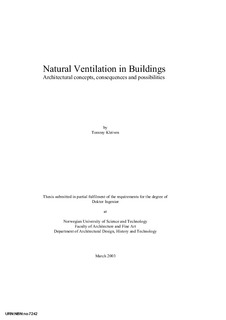Natural ventilation in buildings : architectural concepts, consequences and possibilities
Doctoral thesis
Permanent lenke
http://hdl.handle.net/11250/231090Utgivelsesdato
2003Metadata
Vis full innførselSamlinger
Sammendrag
This thesis, “Natural Ventilation in Buildings -Architectural concepts, consequences and possibilities”, is the result of a PhD study financed by Hydro Aluminium/Wicona, The Research Council of Norway and the Norwegian University of Science and Technology (NTNU). The work was carried out at the Department of Architectural Design, History and Technology, Faculty of Architecture and Fine Art at NTNU in the period January 2000 to March 2003.
The study has been conducted in close collaboration with fellow researchers Bjørn J. Wachenfeldt and Tor Arvid Vik. Chapter 2 “Principles and elements of natural ventilation” is in its entirety written by the three of us together.
The main objectives of this work have been to identify and investigate the architectural consequences and possibilities of natural ventilation in office and school buildings in Northern Europe. Case studies and interviews with architects and HVAC consultants have been the most central “research instruments” in achieving this. Three buildings have been studied in detail. These are the GSW Headquarters in Germany, the B&O Headquarters in Denmark, and the Mediå Primary School in Norway. In addition, a larger set of buildings has been used to substantiate the findings.
The most important findings of this work are that:
- utilisation of natural ventilation in buildings has architectural consequences as well as possibilities.
- natural ventilation primarily affects the facades, the roof/silhouette and the layout and organisation of the interior spaces.
- the ventilation principle applied (single-sided, cross- or stack ventilation) together with the nature of the supply and extract paths, i.e. whether they are local or central, are of key importance for the architectural consequences and possibilities.
- designing a naturally ventilated building is more difficult than designing a similar but mechanically ventilated building. An interdisciplinary approach from the initial stages of design is mandatory for achieving successful natural ventilation concepts.
